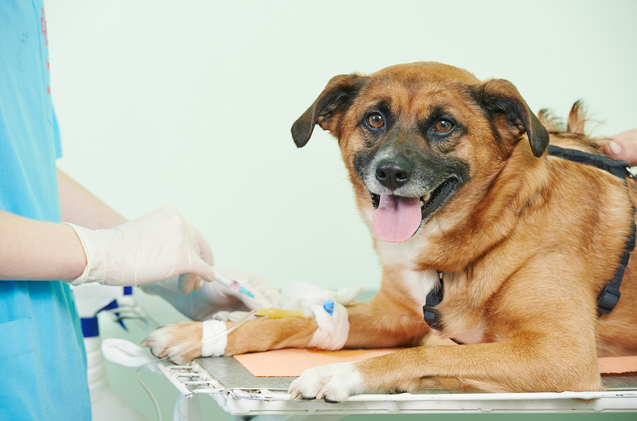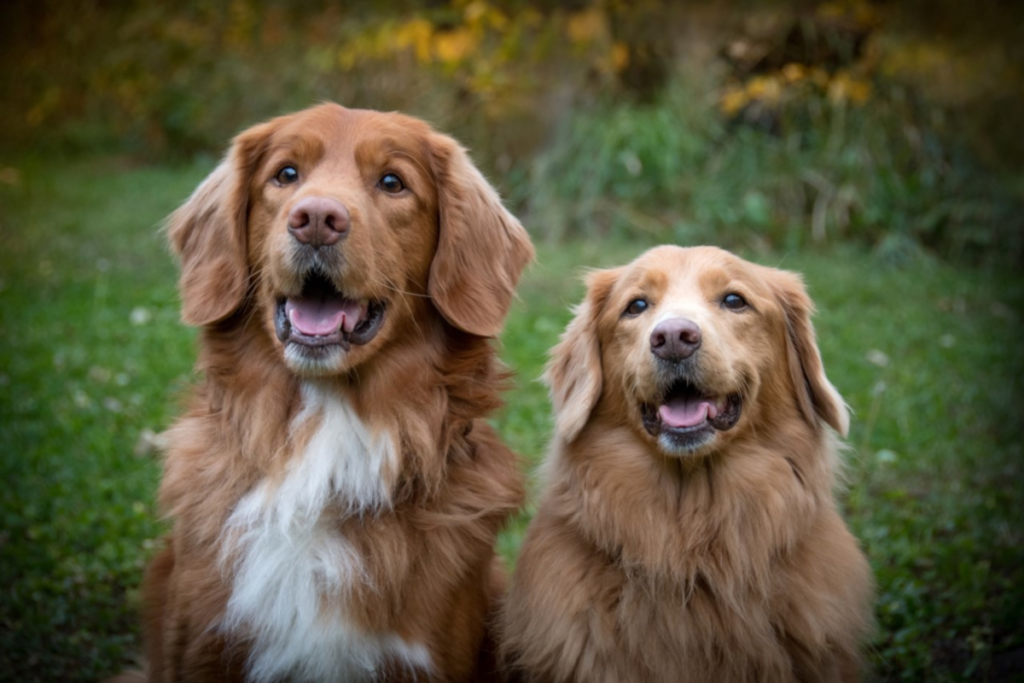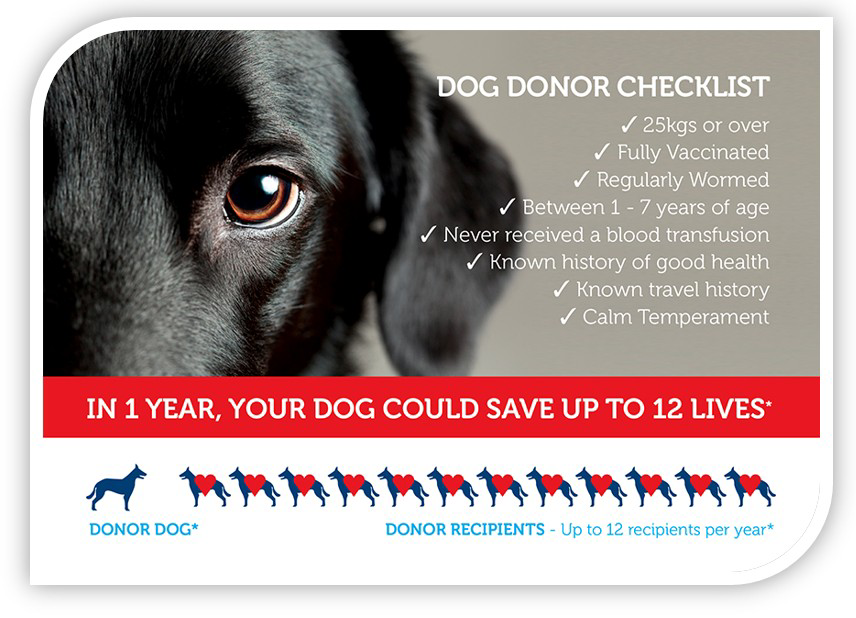4 times a year, we humans can do an amazing, miraculous, life-saving thing to save total strangers who need it most–we can donate blood. There’s always a need for blood and plasma donations; from extreme blood loss in emergencies to helping those with blood disorders and diseases, there really is never too much to go around!
…The same goes for dogs.
Blood donation in canines seems like a really new and profound treatment, but most of the canine blood donation banks worldwide have been open for at least a decade. Just like humans, dogs can require emergency blood transfusions when they have lost a lot of blood, or for long-term management of autoimmune disorders.

Blood Types
Dogs are like humans in that they have multiple blood types. Blood typing is based off of the presence of different antigens and antibodies on the red blood cell membranes of the patient. You probably know your own blood type–A+, O-, AB, et cetera. Humans have 8 common blood types and hundreds of exceptionally rare types, but the common ones are determined by: presence of A antigen, presence of B antigen, presence of anti-A antibody, and presence of Anti-B antibody, as well as the presence of the Rh factor protein. What this means is that if someone with type A blood receives blood from someone whose blood has an anti-A Antibody, the recipient’s blood will clot and possibly burst, most possibly leading to death. Thankfully, this isn’t too much of a problem with dogs!
Where humans have antigens and antibodies present on their red blood cell membranes, dogs only have the antigens–essentially little flags that elicit an immune response from the body. Antibodies–the immune response to antigens in the body–normally only occur in dogs if they have been previously exposed to foreign antibodies by a previous blood transfusion.
The blood of dogs comes in over 12 major groups, called DEA (Dog Erythrocyte Agent) and numbered. DEA 1.1 and 1.2 are the most significant; Dogs with blood type DEA 1.1 positive are universal recipients and can receive any type of blood, but dogs with DEA 1.1 or 1.2 have blood that is more ‘antigenic’ than the other types. This means that the antigens on their red blood cells are more prone to flag down antibodies and produce an autoimmune response that can burst blood cells. After an initial transfusion, a dog will become sensitive to the type of blood they received a transfusion from, as their body has already had an immune response and will protect against it–much like how vaccines work! This is why all Canine Blood Banks will type your dog when they are donating, and will cross-match against the donor’s blood type if they are on the recipient end.
Good news–if your dog tests negative for DEA 1.1 and 1.2, they are considered a universal donor. Hooray!
Blood Collection
As with humans, blood collection is definitely a process. But worry not–like human blood donation, it’s a few minutes out of the day and some R&R before your pup is right as rain again.
First, your dog is placed on their side (whichever is most comfortable). You, the owner, are present the whole time to make this process as easy as possible for your pup. Your job is to keep your pup calm and happy, giving lots of hugs and ear rubs and helping keep them on their side. Which side is used switches with each donation to prevent excess scarring from the needle. Initially a small amount of blood is taken from the paw to determine blood type and other whether your dog is a suitable candidate. Then, depending on results, 450mL of blood is taken from the major jugular vein on the neck as this is one of the largest veins in the body–It is also the fastest and least invasive route to get blood from so as to minimize RBC (red blood cell) trauma.
With one single donation of 450mL, one dog can save up to 4 lives.
In Practice
The actual process of blood collection from your dog is actually rather painless. We spoke with Naomi, the owner of the Fox and Tux Pet Boutique in Edmonton, Alberta whose dog Bullet is a universal donor and has donated twice. Naomi found out about the canine blood donation when Bullet started obsessively sniffing and protecting his older canine sister Abbie. When they brought her in for diagnostics it was discovered that she had a large tumor. Because of Bullet, Abbie lived another 2 ½ years–and Naomi made the decision to keep letting Bullet be a Hero by saving more lives than just his sister’s.

“Bullet is a total trooper for his donations. The staff at the Canadian Animal Blood Bank are all fantastic. They make sure the experience is great for both the dog and the owner. [During the blood collection] the dog lays on a table while the owner gets to cuddle him or her. The donation process itself doesn’t take long at all. After that, you put some pressure on the spot where they took the donation….and then you are good to go. The whole process takes about 15 minutes.”
Side Effects
When prompted about potential side effects of blood donation, Naomi says that “[Bullet] has been totally normal after both donations,” and adds that “They do ask you to keep them relatively low key the day of the donation as they rebuild the blood supply.” The side effects are few and nearly negligible; some owners report a little bit of lethargy after donating, others report slight swelling where the blood was drawn.
Just like we are asked to wait a few minutes and have some sugary juice after we donate blood, dogs need a few moments to adjust to the loss of blood. According to the Pet Blood Bank of the UK, it takes around 24 hours for your dog to fully adjust to the blood being taken, but it can take up to 2 months for the blood supply to be totally replenished. That being said, your dog can only donate blood up to 6 times a year.
Regardless of what the many uses for blood transfusion bags, many vets report a critically low amount of blood donations coming through–not enough to keep up with the numbers of transfusions needed. Veterinarians all across Alberta are pleading for blood donations to save the lives of countless dogs.
How to Get Involved
If you’re interested in donating your dog’s blood, there a couple of caveats. Your dog must be healthy and even-tempered, with a clean medical history: so no infectious diseases, on no medications (except heartworm/flea preventatives), no previous history of transfusion, and no history of pregnancy. For female dogs, they must be spayed, and all dogs must have up to date vaccines (primarily rabies and DHLPP). Size also plays a factor–although blood transfusions can be taken from any breed, they must be over 25kg (55lbs) and between 1-8 years of age.

Most canine blood banks have some great incentives to encourage donation; Bullet, as a result of donating, will receive one free unit of blood component for every unit he donates if he ever requires it in his lifetime from the Canadian Animal Blood Bank. Other blood donation programs give free blood typing or blood analysis, and of course a free bandana to show everyone what a good pup you have!
Finding a place to donate can be as easy as asking your vet–tell them that you want your pet to become a blood donor, and they will hopefully be able to point you in the right direction! You can also check out the Canadian Animal Blood Bank which has clinics open in Alberta, Manitoba, and Ontario.
Special thanks to Naomi from the Fox and Tux Pet Boutique in Edmonton, Alberta for inspiring the idea for this blog and her contributions.
Sources:
